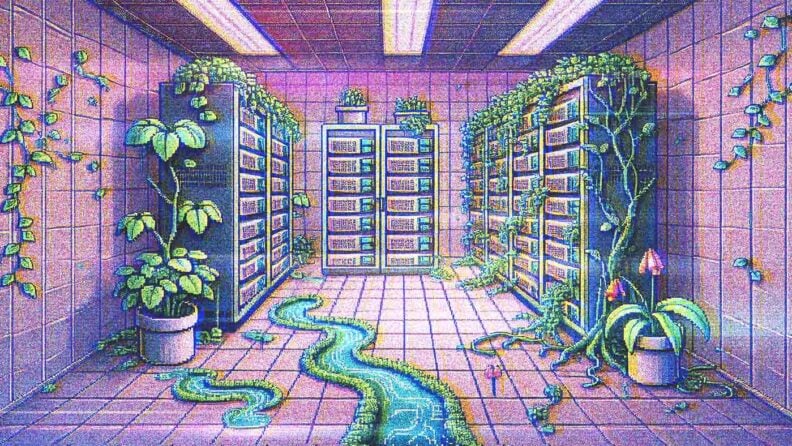The two-year anniversary of ChatGPT is here, and enterprises are going all-in when it comes to generative AI. Research from Deloitte revealed almost two-thirds of businesses are already increasing their investments in generative AI. These investments include a crucial ingredient for AI’s success: data centers.
Data centers power the modern enterprise. They store and process the data that keeps IT infrastructure up and running, making them instrumental in a business's success. While data centers aren’t new, the staggering amount of energy required to develop and deploy generative AI drives energy consumption and costs while also straining the nation’s already outdated grid.
When compared to Google searches, a single ChatGPT query requires nearly 10x as much electricity to process. According to McKinsey research, in order to keep up with current AI adoption, the power needed by data centers is expected to grow three times higher than current capacity by the end of the decade, going from 3-4% of total US power demand to closer to 11-12% by 2030.
Despite the environmental impact, enterprises will continue to invest in generative AI. To rise to the challenge, the tech industry must find ways to deploy AI sustainably. From renewable energy sources to leveraging tech to improve grid infrastructure, tech organizations can lessen their environmental impact and promote the clean energy transition.
Challenges and Opportunities With Going Green
Data centers have a multitude of opportunities when it comes to moving towards more sustainable practices. Like any other commercial property, data centers can transition to more energy-efficient products, from light bulbs to HVAC systems and beyond, and recycle old equipment to reuse parts to cut down on waste, to name a few tactics.
In data centers, organizations can utilize liquid cooling technologies over traditional cooling systems to reduce energy usage. Additionally, data centers can use generative AI programs to identify inefficiencies and optimize operations.
The best opportunity for organizations to go green with their data centers begins with how they get the power. While a large portion of energy from the grid is powered by fossil fuels, businesses can choose to decrease their carbon footprint by avoiding fossil fuel dependence through investments in alternative energy.
Whether that’s pairing renewable energy like solar or wind with battery energy storage solutions (BESS) or using nuclear power, data centers need to rethink their energy procurement strategy.
However, with these opportunities come the challenges of cost and time. Up-front costs for BESS system installation and maintenance and the cost of operating a nuclear power plant are often cause for pause, even though the long-term energy costs with both are significantly less than reliance on the public grid.
While BESS systems are easier to set up and run, nuclear power plants can take decades from inception to actual operation. Reopening closed plants is an uphill battle against the collective memory of nuclear events.
Despite these challenges, these options allow data centers to move toward a greener future, and understanding the pros and cons of both is crucial for decision-makers.
Evaluating Energy Options: Renewables BESS Now, Nuclear Later
BESS solutions are a great starting point and a near-future solution for data centers to move away from reliance on traditional fossil fuels and toward alternative energy sources. When paired with renewables, these systems do more than make data centers green – they also optimize costs as they empower the grid to adapt to fluctuations in supply and demand.
BESS systems can store electricity when costs are low and then dispatch this energy during peak demand periods, providing continuous, stable power at a lower cost. Unlike traditional energy enablement solutions, BESS can react almost immediately to grid fluctuations, providing critical grid stability and flexibility, allowing for critical loads, such as data centers, to operate around the clock.
Additionally, batteries provide backup power in case of outages, further enhancing uptime and system reliability. BESS plays a pivotal role in building a more efficient, stable, and clean energy future by balancing grid loads and dispatching electricity precisely when needed, helping data centers meet sustainability targets without compromising performance or availability.
While safety concerns exist regarding thermal events, thermal runaway—where lithium-ion batteries within BESS systems experience rapid temperature increases leading to fires—is rare. Advanced technologies are in place to monitor battery performance and prevent these events, ensuring system safety and reliability.
Leveraging BESS systems is a smart way for data centers to maintain energy independence and promote the transition to clean energy, and addressing safety measures by following compliance standards can prevent potential safety issues down the road.
Another option for data centers to consider is nuclear power, such as utilizing small reactors and re-opening decommissioned plants to save on building time, which provides reliable energy as nuclear power plants can operate at total capacity - close to 90% - for months at a time.
Nuclear energy doesn’t emit greenhouse gas emissions, making it a viable option for organizations looking to lower their carbon footprint. However, building small reactors or re-opening decommissioned plants is lengthy and can take years to activate. While organizations wait for these reactors and plants to go online, BESS solutions act as an energy enabler in this interim period to help utilities augment renewable energy sources and provide consistent, reliable power.
Energy is an expensive resource, and powering data centers does not have to be an either/or scenario. BESS solutions help data centers achieve their green goals today, while nuclear power remains a viable option for the future. When paired with renewables, BESS solutions can pave the way for a renewable-enabled future, helping to set the stage for energy diversification when a nuclear future arrives.
Nuclear offers longer baseload support, and when combined with BESS as a failsafe, these technologies will ensure the grid stays resilient and adaptable to evolving needs. Nuclear power provides a stable, long-term energy supply, while batteries introduce the flexibility needed to meet short-term demands and make energy consumption more efficient.
Sustainability's Competitive Advantage
Beyond the environmental benefits that BESS systems, renewable energy, and nuclear energy bring, these alternative sources also provide a competitive advantage over data centers that choose not to take action and remain reliant on fossil fuels.
Research has revealed that sustainability is now a top consideration for B2B buyers, leaving money on the table for those unwilling to transform their data centers into green operations. By investing in clean energy, organizations uphold their ESG commitments, attract new customers, and position themselves effectively against competitors who have not risen to the challenge.
Not only does going green save organizations from cost savings upfront, but it also reduces spending in other areas of business. For example, talent management is a costly business operation. With 10% of data center roles remaining unfilled, combined with growing demand for data centers, having access to talent will be crucial for success. When 69% of employed adults want their employers to invest in sustainability efforts, organizations can remain competitive in the talent department by upholding their commitments to going green.
Committing to sustainability is not just the right ethical decision; it’s the best choice for reducing costs and staying ahead of the competition.
Transitioning to green data centers gives enterprises energy independence to power their business operations and improves customer trust, brand reputation, and operational efficiency. Investing in green data centers is the right choice to move towards an innovative, sustainable, and profitable future with technology.
Subscribe to The CTO Club’s newsletter for more on sustainability in tech.



